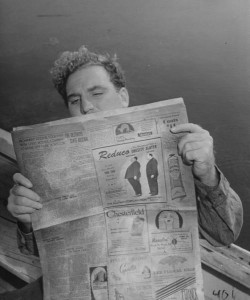 Felix Salmon investigates how newspaper paywalls are evolving:
Felix Salmon investigates how newspaper paywalls are evolving:
In the early days of paywalls, some content was free, while other content you needed to pay for; the meter, in theory, replaced that system with one where the determination as to whether an article was free or not was a function of how many other articles the reader had read, rather than being a function of the content of the article itself.
But this is a bit simplistic:
[I]t’s a mistake — at least from a purely financial perspective — to treat all readers equally. Some readers have a much greater propensity to pay than others; ideally, you want to extract a lot of money from those readers, while also allowing the vast majority of your visitors — the ones who will never pay you anything — to still consume your content and view the associated ads.
For instance, it’s often easier to persuade people to subscribe to sports content than to entertainment content, even as it’s easier to sell ads against entertainment content than it is against sports content. So it does make sense to keep entertainment free, and put some kind of paywall around sports.
He adds:
[I]t seems to be a good idea to offer a range of subscription lengths, priced so that there’s a strong incentive to go for the longer-dated annual subscription, even if again that means a substantially lower rate on a per-month basis.
It’s not all that hard to tell who’s likely to be willing to subscribe, and who isn’t. Print subscribers, for instance, are much more likely to be willing to pay for a digital subscription than a reader who doesn’t already pay for the print version. And people who visit frequently, and who read a lot of local news, or sports news, are also more likely to subscribe.
In general, the trick is to get as many subscribers as you can — because once a person subscribes, they generally turn out to be surprisingly loyal and price-inelastic. You can keep on charging their credit card, even at steadily-rising rates, and they’re not going to unsubscribe. And then, for the 90% of readers who don’t subscribe, it’s a good idea to find content for them, too. The paywall shouldn’t just be a “pay here or get nothing” option: the “no thanks” button should take you to valuable free content.
What lessons can we draw from this? Many museums follow something akin to the original newspaper paywall model: visit the general collection of the museum for free (or for a low price – yes, I still contend it’s a low price), and pay extra for the special exhibition, unless you are a member (subscriber). I can visit the Dallas Museum of Art for free, but will pay $16 if I want to see Cindy Sherman. And if that’s the model of audience willingness-to-pay, then museums are incentivized to have lots of special exhibitions, as Blake Gopnik recently lamented.
Is this the only model we have, then? Or are there other possibilities? Newspapers have some common features with museums (bear with me for the sake of argument!): a large collection of items is presented for which different audiences have different interests and different willingness-to-pay, some content that is quite unique and some that is similar to what could be seen elsewhere, some customers who are occassional visitors and some who are regulars, with the regulars likely to build significant loyalty to the institution (and often to become uneasy with change in the institution). In each case, there has to be something that makes subscription/membership worthwhile – for the most part at museums it is general admission (if there is in fact a general admission fee in the first place) and special exhibitions. But are we limited to that simple dichotomy? Does this model place too much emphasis and reliance on special exhibitions?
A bleg: please let me know of any museums that have adopted a model that breaks from the norm.

Hi Michael,
I wrote this piece five years ago, but it seems apropos to your post: http://museumtwo.blogspot.com/2008/02/thirteen-ways-of-looking-at-admissions.html
Some great food for thought – thanks for sharing this!